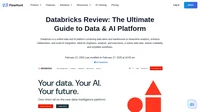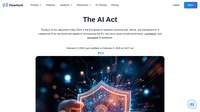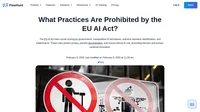What are AI Regulatory Frameworks?
AI regulatory frameworks are structured guidelines and legal measures designed to govern the development, deployment, and use of artificial intelligence technologies. These frameworks aim to ensure that AI systems operate in a manner that is ethical, safe, and aligned with societal values. They address various aspects, including data privacy, transparency, accountability, and risk management, to foster responsible AI innovation while mitigating potential risks to individuals and society.
With the rapid advancement in AI technologies, regulatory frameworks have become crucial. The global push to regulate AI is driven by the need to balance innovation with safety. As computational power increases and AI applications diversify, the potential for both positive impacts and unintended consequences grows. For instance, AI errors can harm individuals’ credit scores or public reputations, and malicious actors can misuse AI to create misleading outputs or deepfakes. To address these challenges, governments and international organizations, such as the G7, UN, and OECD, are actively developing AI frameworks.
Components of AI Regulatory Frameworks
- Ethical Principles and Guidelines: At the core of AI regulatory frameworks are ethical principles that guide the responsible development and use of AI. These include ensuring fairness, avoiding discrimination, maintaining transparency, and safeguarding privacy. Ethical guidelines help in setting standards for AI systems to operate in a manner that respects human rights and societal norms. The frameworks often incorporate human-centered approaches, focusing on creating value for all stakeholders.
- Risk Assessment and Management: Frameworks typically include mechanisms for assessing and managing risks associated with AI applications. AI systems are classified based on their risk levels, such as minimal, limited, high, and unacceptable risks. High-risk AI systems, such as those used in healthcare or law enforcement, are subject to stricter regulations and oversight. The global trend indicates a move towards a nuanced understanding of AI risks, requiring adaptable frameworks to keep pace with technological evolution.
- Transparency and Explainability: Transparency in AI systems is crucial for building trust and accountability. Regulatory frameworks often mandate that AI systems should be explainable, allowing users and stakeholders to understand how decisions are made. This is particularly important in high-stakes areas like finance and healthcare, where AI decisions can have significant impacts. Efforts to improve explainability are ongoing, with various jurisdictions exploring different approaches to ensure clarity in AI operations.
- Data Privacy and Protection: Protecting personal data is a fundamental aspect of AI regulation. Frameworks set out rules for the collection, storage, and use of data, ensuring that AI systems comply with data protection laws like the General Data Protection Regulation (GDPR) in the European Union. As AI systems increasingly rely on data-driven insights, robust privacy protections are essential to maintain public trust and prevent misuse of personal information.
- Accountability and Governance: AI regulatory frameworks establish clear lines of accountability, ensuring that developers and operators of AI systems are responsible for their actions. Governance structures may involve national or international bodies to oversee compliance and enforce regulations. With varying definitions and regulatory approaches across jurisdictions, international businesses face challenges in aligning with multiple standards, necessitating a “highest common denominator” approach to compliance.
Examples of AI Regulatory Frameworks
- The EU AI Act: This is one of the most comprehensive AI regulatory frameworks globally. It categorizes AI systems based on risk and imposes obligations on developers and users accordingly. High-risk AI systems are subject to stringent requirements, including risk assessments, quality data management, and human oversight. The EU AI Act aims to harmonize AI regulation across member states, addressing ethical and safety concerns while promoting innovation.
- The Singapore Model AI Governance Framework: This framework emphasizes a balanced approach to AI regulation, focusing on transparency, fairness, and safety while encouraging innovation. It provides practical guidance for organizations to implement responsible AI solutions. Singapore’s approach serves as a model for other countries seeking to integrate AI regulation with economic growth strategies.
- The US Approach: The United States has a more decentralized approach to AI regulation, with state-specific laws and industry-driven guidelines. The focus is on fostering innovation while addressing issues like data privacy and algorithmic bias. As federal AI legislation remains unlikely in the near term, agencies like the Federal Trade Commission (FTC) play a critical role in addressing public concerns and investigating AI platforms.
Use Cases and Applications
AI regulatory frameworks are applicable across various sectors, each with unique requirements and challenges. Here are some examples:
- Healthcare: In healthcare, AI is used for diagnostics, treatment planning, and patient management. Regulatory frameworks ensure that AI systems in healthcare are safe, secure, and provide accurate results without compromising patient privacy. As AI transforms healthcare delivery, frameworks must adapt to new applications and technologies to maintain safety standards.
- Finance: AI is employed for fraud detection, credit scoring, and investment analysis. Frameworks ensure that financial AI systems are transparent, fair, and comply with financial regulations to prevent discrimination and bias. The financial sector’s reliance on AI underscores the need for robust regulatory measures to protect consumers and ensure market stability.
- Law Enforcement: AI tools are used for surveillance, crime prediction, and forensic analysis. Regulatory frameworks restrict the use of high-risk AI applications, particularly those involving remote biometric identification systems, to protect civil liberties. As debates over AI’s role in law enforcement continue, frameworks must balance security needs with privacy rights.
- Transportation: AI systems in transportation, such as autonomous vehicles, are subject to stringent safety standards and risk assessments to ensure public safety. The transportation sector exemplifies the challenges of integrating AI into critical infrastructure, necessitating comprehensive regulatory oversight.
Global Trends and Challenges
The development and implementation of AI regulatory frameworks face several challenges, including:
- Technological Advancements: AI technologies evolve rapidly, often outpacing regulatory measures. Frameworks must be adaptable to keep up with technological changes and address emerging risks. The fast-paced nature of AI innovation requires ongoing collaboration between regulators, industry, and academia to identify and mitigate potential issues.
- International Coordination: As AI systems often operate across borders, international coordination is crucial to harmonize regulations and prevent fragmentation. Organizations like the OECD and the G7 are working towards global AI governance standards. Efforts to achieve international consensus face obstacles due to differing policy priorities and regulatory approaches.
- Balancing Innovation and Regulation: Striking the right balance between encouraging AI innovation and imposing necessary regulations is a critical challenge. Over-regulation can stifle innovation, while under-regulation can lead to ethical and security issues. Policymakers must navigate this balance to foster an environment conducive to responsible AI development.
- Sector-Specific Regulations: Different sectors have varied needs and risks associated with AI use. Regulatory frameworks must be flexible enough to accommodate sector-specific requirements while maintaining overarching ethical and safety standards. Tailored regulations can help address the unique challenges faced by industries adopting AI technologies.
Databricks Review: The Ultimate Guide to Data & AI Platform
Discover Databricks, the ultimate data & AI platform unifying data lakes & warehouses for scalable, collaborative, and AI-driven insights."
Chatbots under the European AI Act
Discover how the European AI Act impacts chatbots with key compliance rules, risk categories & deadlines. Stay informed to build ethical AI!"
What Practices Are Prohibited by the EU AI Act?
Discover prohibited AI practices under the EU AI Act, including bans on social scoring, manipulative AI, and real-time biometric systems.



